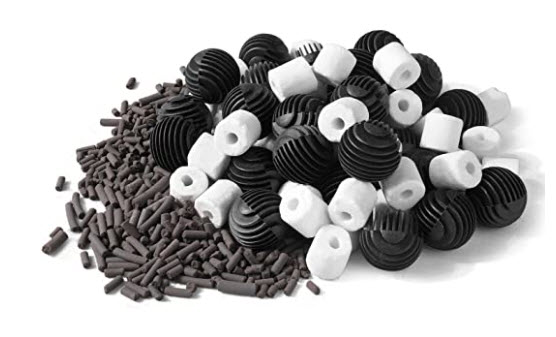
If one works all the numbers on biofiltration media in the aquarium filter you come up with two very interesting tables on the basis of volume (cubic inches). The first volume table is based on the well established fact that ammonia oxidation needs 5 square feet of effective biomedia surface area per metabolic pound of fish.
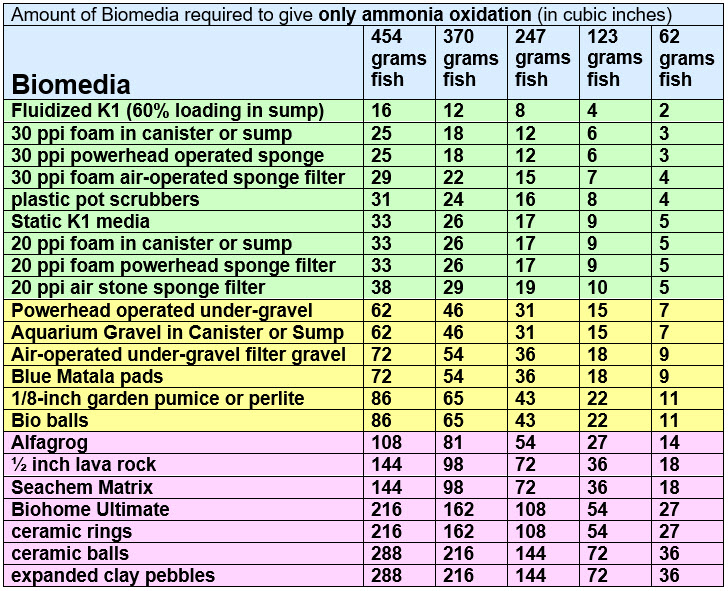
If one wants crystal clear water and healthy fish, ammonia oxidation is only a small part of the story. For heathy fish and crystal clear water one wants at least 100 square feet of surface area per metabolic pound of fish. This gives a considerably different table.
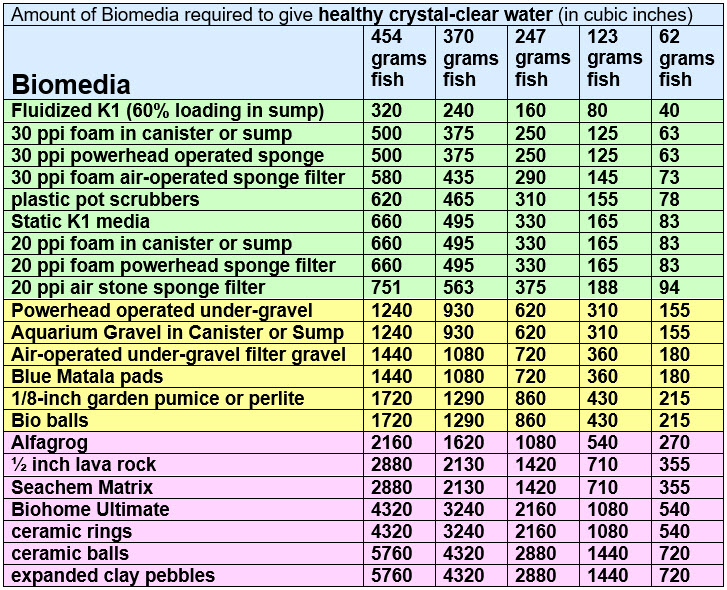
Most of the media numbers represent what a given volume (cubic inches) of media will do stationary in a canister, sump or hang-on-back filter. We’ve added fluidized bed K1, 30 ppi, 20 ppi sponge filters and an undergravel filter gravel as media in order to give a more complete picture.
It has to be emphasized that these volume tables apply for fish fed at a 1% feeding load of typical commercial dry fish food. This is typical for adult fish. Obviously if one uses a 2% feeding (juvenile fish) load will require twice the media. If you feed your fish per the directions on most fish food containers (“what they can eat in five minutes three times a day“) you will need like ten times the volume of media.
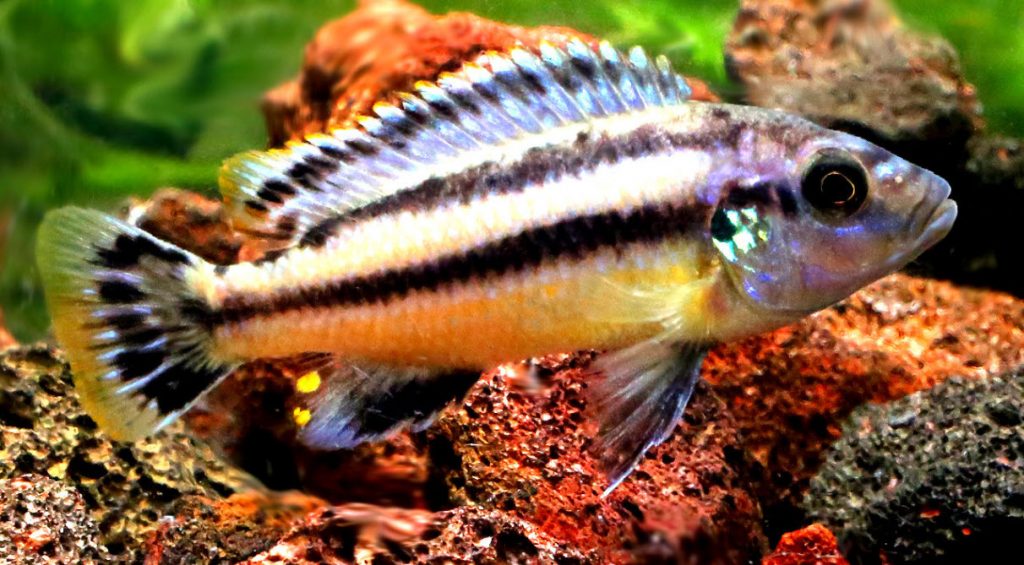
Depending on what your goals are for your aquarium, only ammonia oxidation or crystal clear, healthy water, one can now calculate the media needs for any given aquarium. The only missing piece is the metabolic weight of the fish.
One surprisingly accurate way to tell the weight in grams is to multiply the length by the width by the height in inches (I know, we’re mixing measurement systems but that the rule!). Each calculated cubic inch is very roughly 10 grams of fish. So
- a “normal fish” a five inch peacock (including tail) is 5 inches by 1.5 inches tall by half an inch wide gives 5×1.5×0.5=3.75 – 3.75x 10= 38 grams.
- A five inch discus (including tail) which is 3.5 inches high and 3/8ths of an inch wide is 5×3.5×0.375=6.6 – 6.6×10= 66 grams.
- A five inch fancy goldfish is 5×1.6×1.6=12.8 – 12.8×10= 128 grams.
We will use what researchers have found. Researchers have compiled lists of the weights of very many fish and set up an equation to calculate the weight of the “average” fish. Using the equations and correction factors a table is easily set up for the “average” fish.
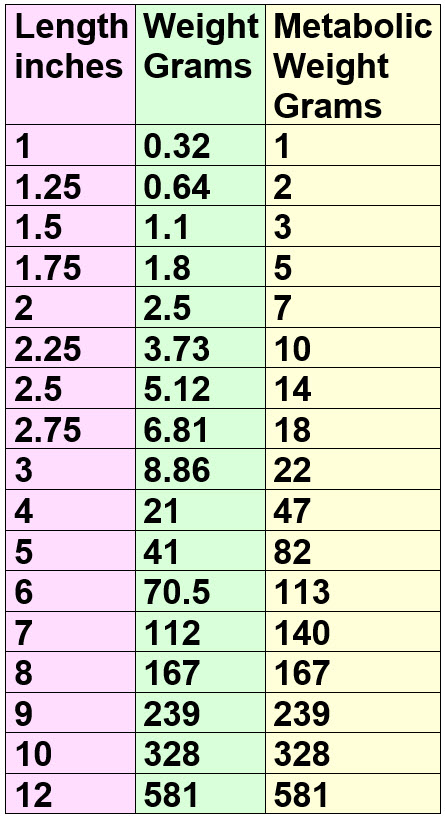
The “metabolic” weight reflects the fact that small fish swim much more than large fish, burn up far more calories, and thus give a lot more bioload per gram of fish than do large fish. But note this has to be tempered by the shape of the fish and how active they are.
A wide bodied fancy goldfish can weigh three times what its length says it should weigh. A slow moving catfish will only have the actual weight, not the metabolic weight. Surprisingly, tall fish like discus and angelfish are only twice the weight of a similar “normal” fish shape. But also note that long flowing fins like a guppy has have to be ignored in the length calculation. All these considerations makes knowing the actual metabolic weight kind of a guessing game.
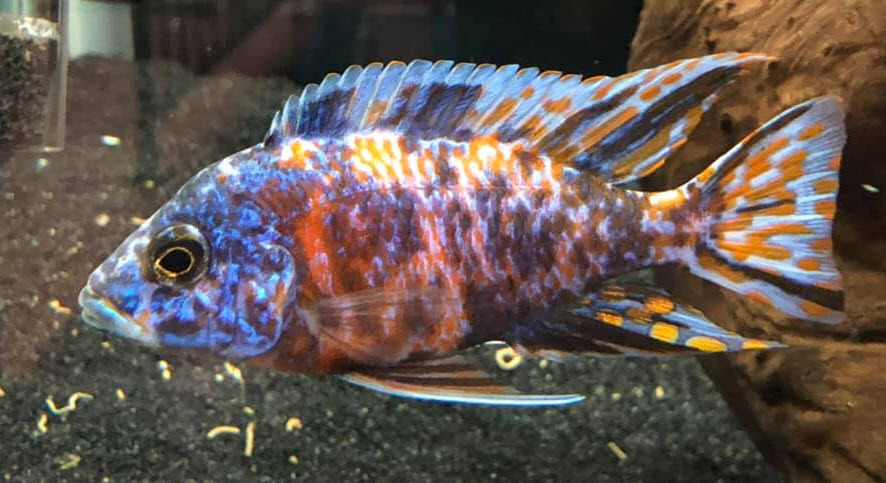
If one were starting out and put together a typical aquarium with a bottom to top flow hang-on-back filter, what would be the minimum amount of each type of biomedia one could have?
Let’s assume the stocking was a community aquarium with three 3″ angelfish, two bristle nosed plecos, and one opaline gourami. Because the angelfish are tall one has to multiply 22 by 2. So three angelfish are 132 grams, a 4″ bristle nosed pleco is only 21 grams because he moves very slow, and one 4″ opaline gourami is 47 grams. This is 132+21+47 = right about 221 grams metabolic weight.
Let us say you have a bottom to top flow hang on back with 10 inches by 2 inches by 8 inches of room for media. That is 160 cubic inches (10 x 2 x 8). What will be the media types you can use for ONLY ammonia oxidation with 221 grams metabolic weight of fish? Note the gallons of water and GPH is immaterial.
So the volume chart goes to this:
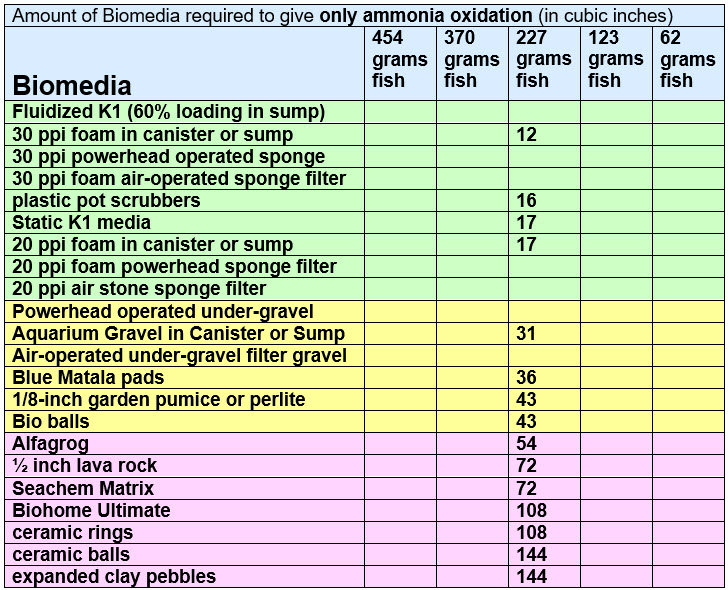
Ammonia oxidation is EASY and all the media in an HOB will do the job for this 200 gram fish aquarium.
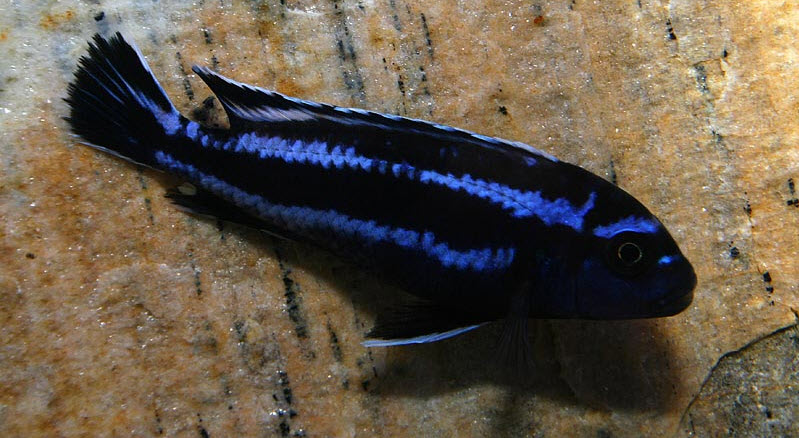
Now let us say that we have the same situation: a bottom to top flow hang-on-back with 160 cubic inches and roughly 221 grams metabolic weight of fish. What is the media which will give us CRYSTAL CLEAR, BACTERIA FREE, HEALTHY WATER?
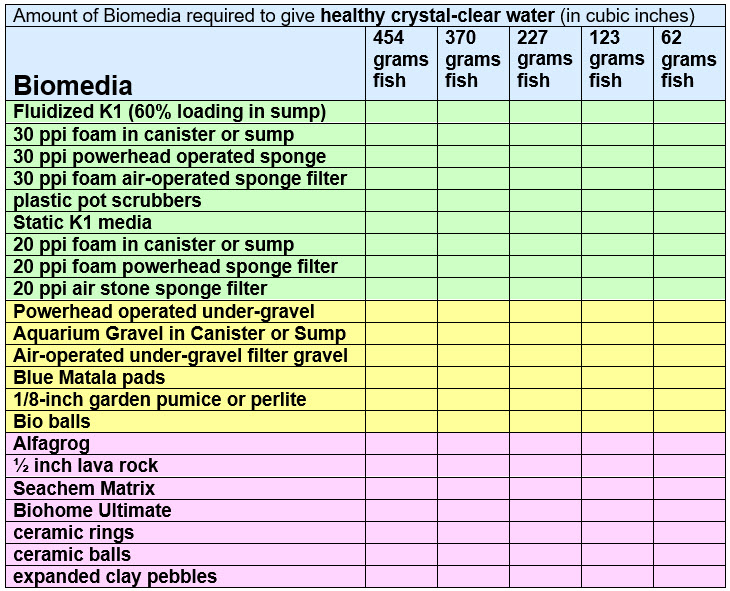
That’s right: there is NO media which will give crystal clear water with a typical moderate loading of fish and a typical bottom to top flow HOB filter.
Now since there are at least 12 variables (food level, protein level in food, aeration, etc.) affecting water clarity it is possible to have a very healthy, crystal clear aquarium with this loading and a bottom to top flow hang on back. Possible but not probable.
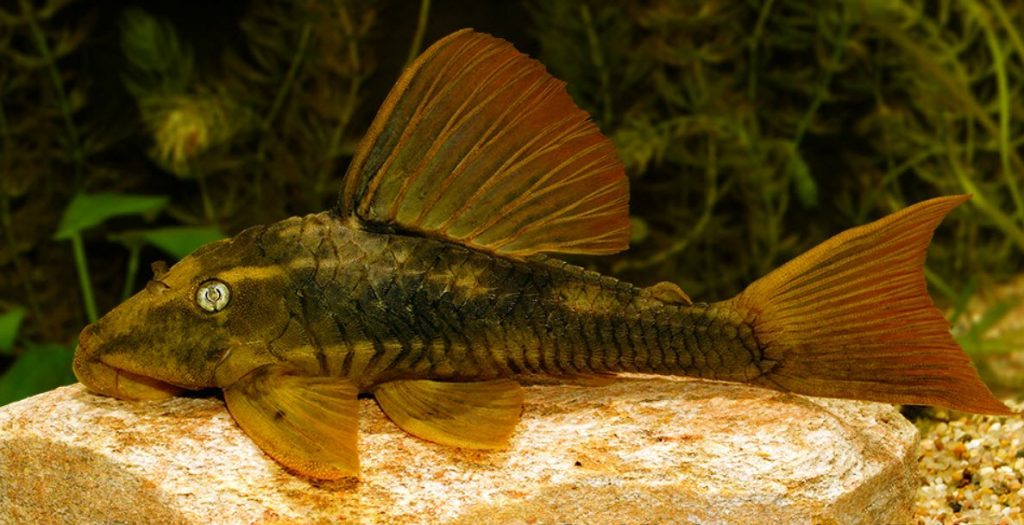
Doing some other situations:
So let us say you have an aquarium with a fully grown 11 inch Oscar that weighs over 450 grams (about one pound) metabolic weight. And you have a large canister with 700 cubic inches (3 gallons, 0.4 cubic feet, 11 liters). What media will give you crystal clear water that will keep hole-in-the-head at bay?
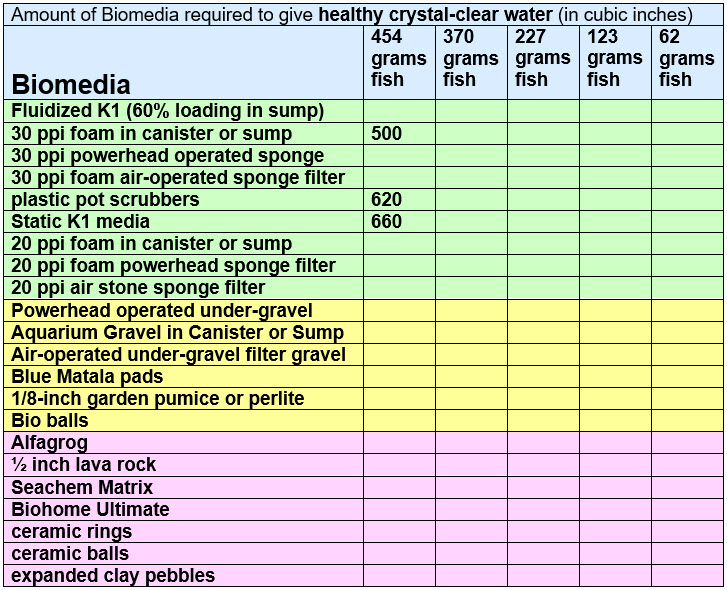
Per the above only 30 ppi foam, plastic pot scrubbers and static K1 media will give an Oscar complete freedom from the POSSIBILITY of hole-in-the-head syndrome. Note the gallons of water in the aquarium and the GPH are immaterial.
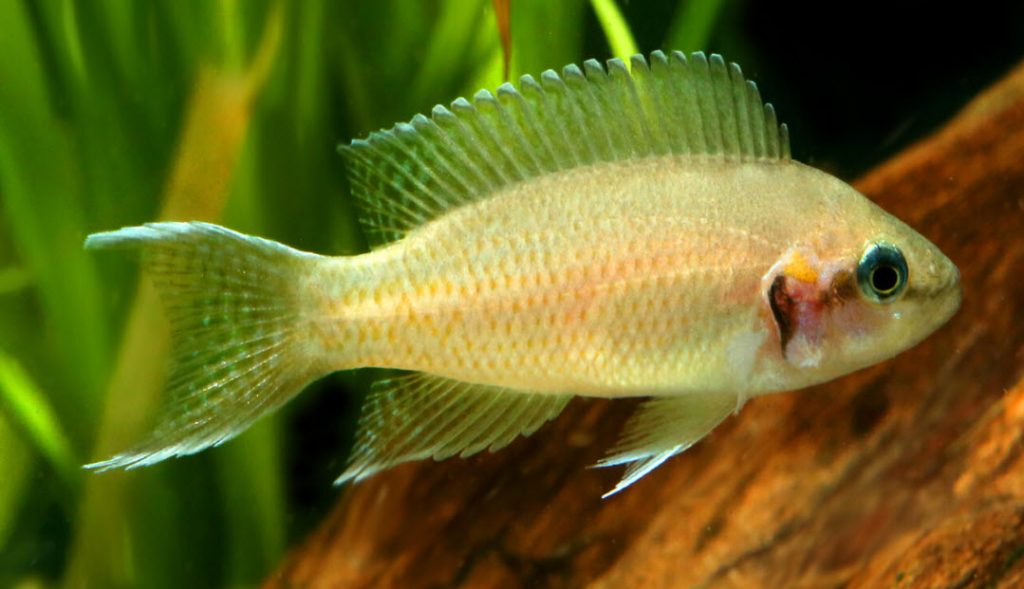
So let us say you have an aquarium with 123 grams metabolic weight of fish. And you have a big canister with 700 cubic inches (3 gallons, 0.4 cubic feet, 11 liters). What media will give you crystal clear water? Per the below most of the media will do that. Note the gallons of water in the aquarium and the GPH are immaterial.
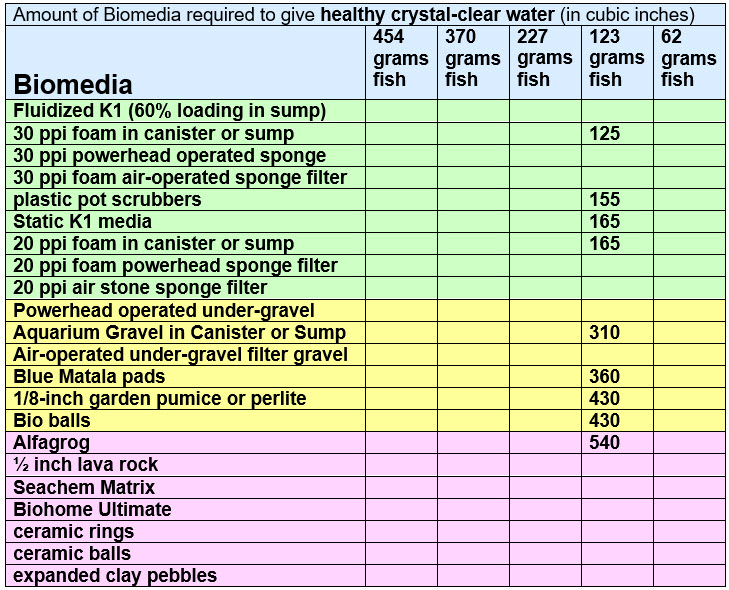
.
Again, it has to be emphasized that these tables apply for fish fed at a 1% feeding load of typical commercial dry fish food once a day. 1% is typical for adult fish. Obviously if one uses a 2% feeding (juvenile fish) load will require twice the media.
.
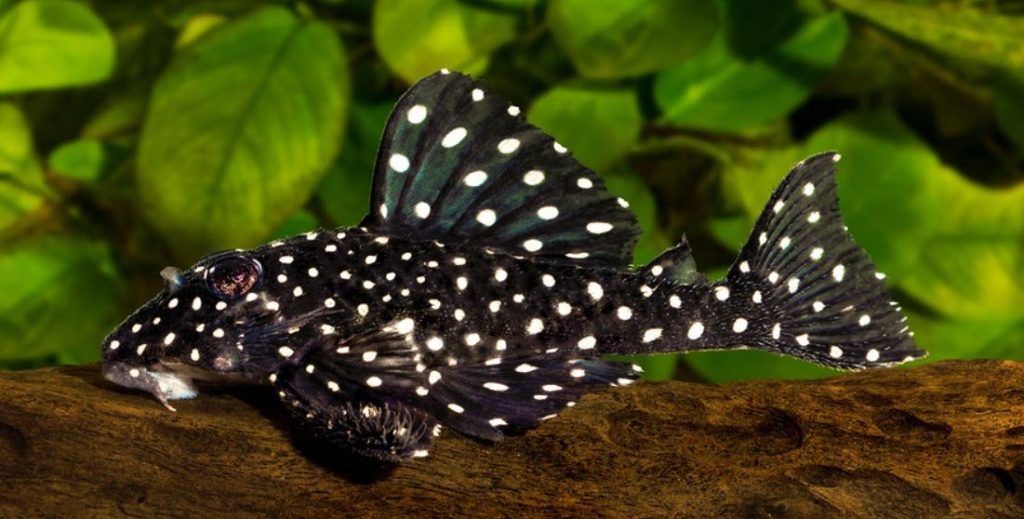
An Illustration
Here is a comment to this web page and its answer:
“Paul
I have a 75-gallon community tank with an EHEIM 2217 canister filter. I’m planning to replace all the EHEIM filter media with Swiss Tropical 20 PPI Poret foam. I’m thinking of having 5 foam pads, each 2” thick and 7” in diameter. Would this give me the 220 sq. ft of effective surface area mentioned in your chart? Using one of your other charts, I calculate that I have 0.75 lbs of fish. Using the 100 sq. ft for 1 lb. of fish metric, I would think I’ll be able to easily accommodate more fish – is that right? I’m planning to use your recommendation to squeeze liquid from the existing filter pads onto the new pads to jump start the cycling of the new foam. How long do you think I should wait before adding more fish? Thanks for your help.
Dave
OK you have a cylinder ten inches tall and 7 inches in diameter. V = π r2 h π x 3.5 x 3.5 x 10 = 384 This will give one 384 cubic inches of 20 ppi foam. 12x12x12 is 1,728 So you will have 384/1,728 or 0.222 cubic feet. 0.222 x 220 = 49 square feet. So you can do 0.49 pounds of fish at the 100 square foot per pound of fish metric. At the current time you are at (0.49×100)/0.75 = 65 square feet per pound of fish. 65 square feet is good, but it isn’t 100 square feet. So you cannot accommodate more fish.”
And you can add fish right away and just not feed them for a few weeks or wait literally as long as you are comfortable with. I add pond mud (see the article on the “mature aquarium”) and wait at least six weeks minimum but I’m a little nuts.
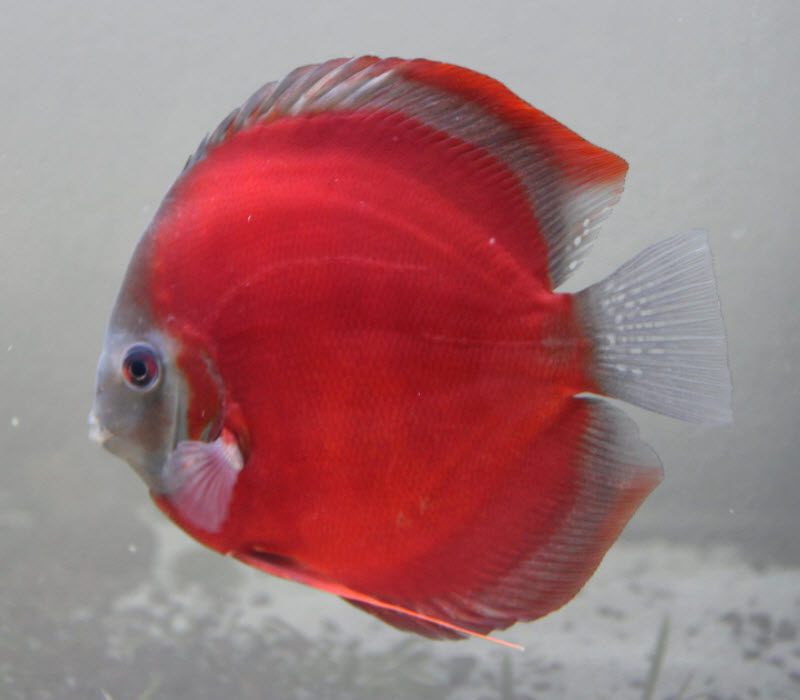
Another Example of Aquarium Filter Media Calculations
This exchange is from the comments section of this website:
Question #1
“Hi there,
I’m reaching out for some clarity on ‘Square Feet of Biomedia Surface Area’. I’m considering the 5″ Poret® Foam Sheets (26 × 19.5″ Sheet) and am wondering what the calculations would be for cubic sq. ft.? I plan on executing the ‘10 ft2/gallon of water’ OR ‘100 ft2/pound of fish.’”
Answer #1
“To calculate the volume the math is 5 inch x 26 inch x 19.5 inch / 12 inch x 12 inch x 12inch = 1.47 cubic feet per sheet of Poret® Foam. With a 20 ppi Poret® foam (what I recommend) which has about 220 square feet of effective surface area per cubic foot, this is 1.47 x 220 = 323 square feet. So If you use the whole sheet of Poret® you can support roughly 3.23 pounds of fish in a healthy environment (100 square feet of surface area per pound of fish). And I don’t recommend “10 ft2/gallon of water”. Go ONLY with the “100 ft2/pound of fish”.
Question #2
“Thank you so much for the reply but I’m still confused. Essentially I’m wondering how many – 5″ deep x 26″ long x 19.5″ high Poret® Foam Sheets, will I need for 13.2 lbs. of fish (24 × 8.8 oz Discus or 24 x 8.8/16)?”
Answer #2
“The calculation for 13.2 pounds of fish is 13.2 pounds divided by 3.23 pounds equals four sheets of 5″ deep x 26″ long x 19.5″ high Poret® Foam”
These examples illustrate the process very well.
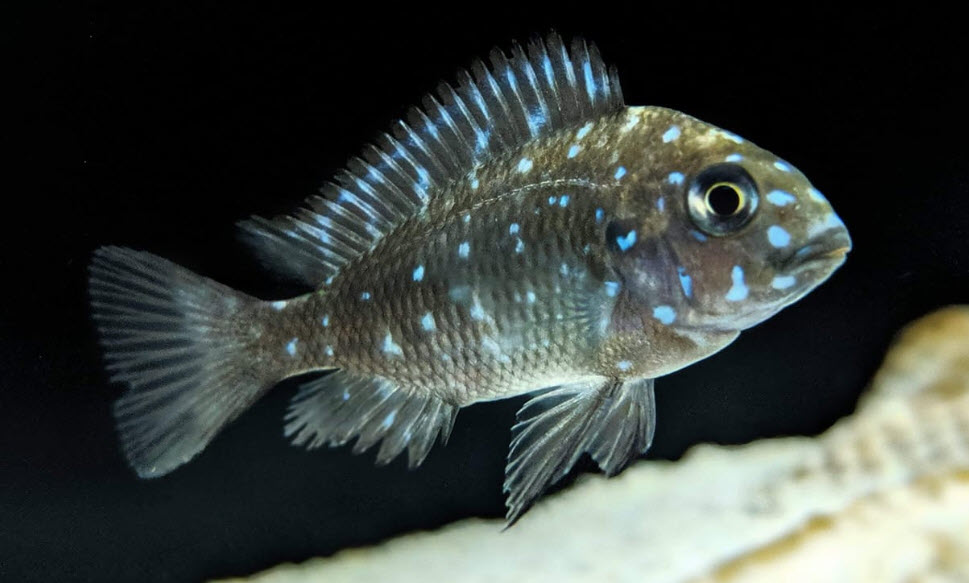
Sump Considerations
If one is doing the calculations for a sump one should be aware that fluidized bed K1 is roughly 58% more efficient than static 30 ppi foam as far as filtration. The effective surface area considerations are that fluidized K1 is 900 square feet per cubic foot of media. At 60% loading this becomes 540 square feet per cubic foot of sump filter.
Foam with 30 pores per inch has a surface area of 340 square feet per cubic foot. 540/340= 1.58
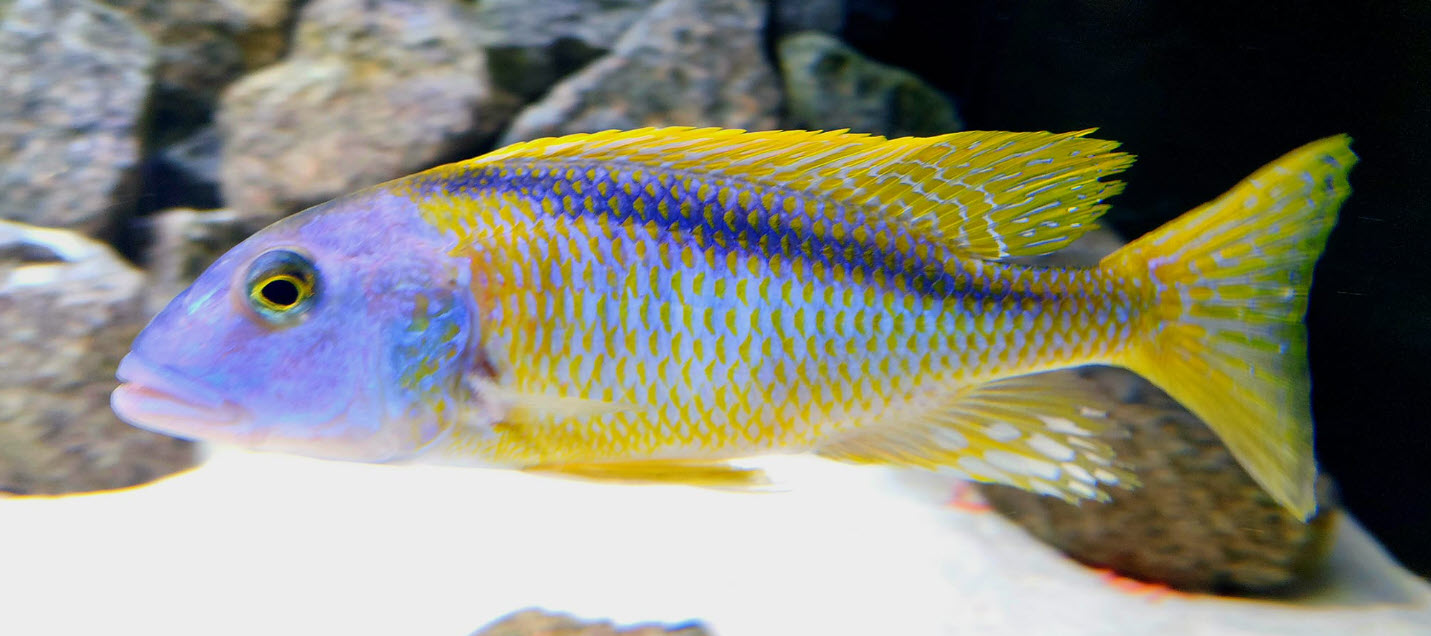
Still another illustration:
Question:
How do you calculate the surface area in media used for biological filtration? For example, I have 30 pot scrubbers and some foam in a Fluval 407 canister filter on a 75 gallon tank.
Reply
OK Each pot scrubber is roughly nine cubic inches of media (large pot scrubbers???). 9×30/12x12x12 = 0.156 cubic feet. Pot scrubbers are 260 square feet per cubic foot media (I could be off on that). 0.156x 260 = 40 square feet from the pot scrubbers. If I remember right a 407 has a piece of 30 ppi foam that is 10 inches x 1 inch x 14 inches. 10x1x12/12x12x12= 0.081 cubic feet. Foam is about 340 square feet per cubic feet 0.081×340 = 27.5 square feet. 27.5 + 40 = 67.5 square feet. That is just off the top of my head. You need to correct the numbers depending on the size of your pot scrubbers and the true size of the 407 foam.
Calculations for a pond
A pond requires different graphs and different calculations:
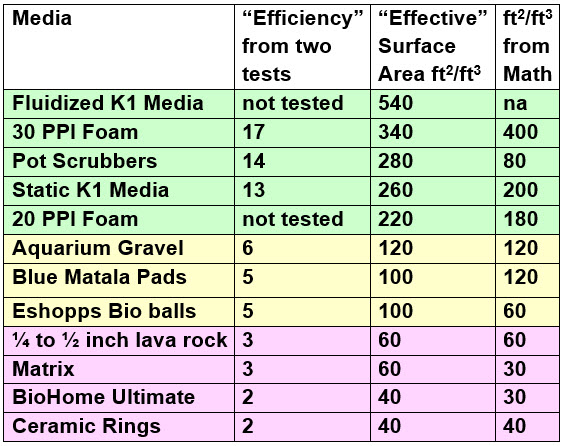
Still another illustration:
Question:
I am planning a pond of approx. 29000 gallons. I have chosen to buy Japanese imported butterfly koi. not bought or created yet as I am in planning mode, and want this right the first time. I will have a k1 fluidized bed, for the main biofilter, and I want to do this for crystal clear water, and super healthy fish…… So if each mature adult koi will end up being ??’8′?? pounds, how many for a heavy stocked 29000 gallon pond, and most importantly how much k1 fluidized? How many gallons of moving k1 should I have for each koi and altogether? I just cant seem to figure it out.
Answer:
You need to work with cubic feet for a pond, It gets pretty big pretty fast. Let us say you want one koi per thousand gallons, or 29 koi. 29 Koi with 100 square ft of surface area per pound is 2900 square feet. So you want 2900 square feet times eight of surface area or 23,200 square feet on your fluidized K1. Each cubic foot of K1 gives roughly 540 square feet. 2900 divided by 540 equals roughly 5.2 cubic feet. Times eight = 43 cubic feet. (alternatively 23,200 divided by 540 equals 43 cubic feet) So you will need a fluidized bed which is 3 foot high 4 foot wide and 3.6 foot deep (three times four times 3.6 equals 43 cubic feet).
Another way to look at it is that an eight pound koi will 8×100 or 800 square feet of fluidized K1. 800 divided by 540 = 1.5 cubic feet of fluidized K1 per koi. 29 koi need 29 times 1.5 or 43.5 cubic feet.
Further Research
For more on how to calculate filter volume go to these articles:
8.8. Filter and Media Design
8.8.1. Sizing Filters in Depth
7.6. Required Aquarium Filter Media Surface Area
.
Return to Filter Media Menu
.
Aquarium Science Website
The chapters shown below or on the right side in maroon lead to close to 400 articles on all aspects of keeping a freshwater aquarium. These articles have NO links to profit making sites and are thus unbiased in their recommendations, unlike all the for-profit sites you will find with Google. Bookmark and browse!
.

Dave says
In reply to David ….. I would go to a powerhead on the lift. And there is no problem with an occasional treat.
David says
Hi Dave,
I’ve done a lot of reading of your articles, done some of my own calculations, and I still have some questions for you if you don’t mind.
I’ve already set up a 20 gallon high with 2-3 inches of black diamond blasting media over ¾ inches of oil dry clay, which is then on top of an old school Penn Plax UGF plate.
The oil dry is from trying to follow the “anoxic filtration” which I’m very thankful you took the time to thoroughly debunk.
Per your calculations I need about 620 cu in of gravel for crystal clear water with 247 metabolic grams of fish.
My planned stock is 6-8 panda cories, 6-8 platies, 12 of some sort of smaller schoolers, and the extra few odd snails (a mystery, a japanese trapdoor, and some MTS). If I really need more, MAYBE 8 danios a few months down the road.
My very uneducated figuring gives me about 2 inches average per fish which gives me roughly around 60 inches of fish. That comes down to 210 metabolic grams (30 2 in fish x 7 metabolic grams) which is under the limit of 247 requiring 620 cu in of gravel.
Using the rough measurements of my tank and height of gravel (24x12x3) gives me 864 cu inches of media.
IF I stuck to the strict feeding and IF this substrate were gravel I’d be ok, right?
But my question is if this media close to gravel in biofiltration capacity? If so, would I still have room for the occasional veggie or bloodworm treat, within reason of course?
The current set up has been cycling for about 6 weeks and is turning 1 tbsp of urine into .25 ppm of ammonia within one day, if that means anything. It’s still cycling currently with nitrites off the charts. There are no live plants (won’t be for a few months).
Another question I have is that this UGF is being powered by a USB powered 1 watt air pump, connected to the airstone inside the lift tube that came with the UGF. The lift tube was also cut short (because “anoxic filtration needs slow flow”).
Is this enough flow? Should I just lengthen the lift tube? If I need anything more powerful I’ll go to a powerhead, because anything more than the almost silent unit I’m running now can’t be tolerated, which is fine, too.
While I suspected this wasn’t enough flow to power the whole bed, the cycling of that much urine has me kind of shocked.
To sum up my questions;
1) Will my current air pump work with my current media setup for my planned bioload?
2) Do I have any breathing room for treating the fish occasionally?
I have a 2217 Eheim filled with pot scrubbers that would leave no doubt to any of this, but I’d rather not use it if I don’t have to because of space, leakage, and power outage concerns.
I apologize for the long winded question, I did a lot of calculations not mentioned, and I tried to make this as sort and precise as possible.
I highly appreciate the information you’ve given here already. Thank you for your priceless contributions to this wonderful hobby!
Dave says
In reply to Julian ……. Sounds about right.
Julian says
Say I wanted to stock a tank with 15 Mbuna that reach about 5inches. That would be a metabolic weight of approximately 1230g or 2.7 pounds. This would mean that for this load and to achieve 100ft^2 of biomedia per pound of metabolic fish weight I would need 270 ft^2 of biomedia. Say I was to utilise static K1 media, would I be correct in saying I would need 660×2.7 = 1782 cubic inches of K1?
Dave says
In reply to Sotiris …. I would go with the 20 ppi. Slightly less filtration per se but fewer cleanings required. I’m just really very lazy and hate the idea of completely tearing down a canister every three months of so. With 20 ppi I find I can often NEVER clean the foam in a canister.
Sotiris says
Hello, first of all I want to thank you for the great help that I find in your articles. Well documented and not the “do this, I did it and worked fine” logic.
I’ve estimated my fish (Metabolic weight) and is about 180grms. Now I have a canister filter with 210 cubic inches volume and I’m thinking of using 20ppm foam but is close to the limit I think. Shall I use 30ppm to more to the safe side?
Regards
Dave says
In reply to Scott ……The rule applies across all freshwater systems. For ponds I like a fifty fifty system with 50% 20 ppi foam and 50% fluidized bed K1
Scott Bogard says
Hello! So I’ve spent a day or so studying this website, and I have some questions. I have a 2000 gallon garden pond. It has about 20 mostly adult goldfish in it (adding a few more every year, due to breeding), which I feed 1 tablespoon of food (40% protein) once or twice a day depending on the temps outside (more in the summer). I also have tons of water lilies, in various states of growth and decomposition. I had a long post with lots of specs, but I’m not trying to waste your time, so suffice it to say I’ve done the math using your equations (and a little interpolation), and my current filtration (1cuft of 10ppi foam) feels hugely inadequate. My water is mostly clear, but I test traces of ammonia, particularly when it is warm outside.
My big question is, in a messy, large system like this, does the 100 sq ft/lb rule still apply? Is there any leniency given the heavily planted nature of a garden pond, or is that considered a zero sum game because most everything that grows in the pond, dies there, come winter time? Lastly, does a K1 fluidized filter need a mechanical prefilter (like foam or K1 static), or if it is sufficiently large for the stocking level, is that unnecessary? I’d like to start with 2 cuft of K1 (in a 4 cuft vessel) but I’m having trouble deciding if I want to do a larger foam pre-filter, or K1 static? Or just several chambers of K1 fluidized. Thanks!
Dave says
In reply to Aviad …. Simply make it the largest sump one can fit into the location chosen. A forty gallon should do the trick quite well.
The calculations are one third pound per adult discus times twenty equals 6.6 pounds of fish. Times 100 square feet equals 660 sq. ft. needed. 660 divided by 540 equals 1.22 cubic feet equals 9.1 gallons minimum of fluidized bed. So, while a ten gallon fluidized bed will give you 100 square feet per pound of fish I recommend going with a forty gallon sump to give 400 square feet per pound of fish. Discus love to be in well filtered water.
Aviad Trabelsi says
Hello Dave.
I’m sorry I couldn’t properly understand your calculation for K1 Media
I would like to know the Moving Bed chamber size and how many fluidized K1
For 20 adult discus
Best Regards
Aviad Trabelsi.Israel
Brad - UK says
@Ysabelle Aleman
Your Eheim filter has a capacity for media of around 5 litres, or around 305 Cubic Inches of available space – VERY approximately. If you stuffed that with 30 PPI Foam, that would give you around 115 grams of fish at the 200Ft/2. (or 230 grams at 100ft/2).
That will allow you to have (very approximately) 20 x 2-inch fish OR 6 x 3-inch fish OR 3 x 4-inch fish. If you only target 100ft/2, double the amount of fish (i.e., you could have 12 x 3-inch fish).
Brad
Dave says
IN reply to Ysabelle ….. All I can tell you is to reread this article about ten times. The process is not an easy one and try as I might I can’t condense it. Alternatively simply fill the canister with one of three media: foam, pot scrubbers (what I use) or stationary K1 media. That will give you the best you can do with that filter alone. PS throw out the loading directions which came with the filter. They are confusing and worthless.
Ysabelle Aleman says
I’m sorry I’m just confused on how to get crystal clear healthy water. I don’t know how much of each biofiltration to use or which ones to use. It’s very confusing. I also have a 60 gal tank and a ehiem pro4 350 canister filter. I need 200 square feet – how do I calculate that into how much biofiltration I need. And how much of each to use? Thank you so much for your help!
Ysabelle Aleman says
Yes I know I need 200 square feet. I’m just confused as to what biofilter to use? There’s multiple listed and I’m not sure which one to use or how much of each to use in my canister filter. I have the ehiem pro4+ 350.
Dave says
In reply to Ysabelle You need 200 square feet of biofiltration. Since all three types of biofiltration are going on simultaneously on the same surfaces you can’t separate them.
Ysabelle Aleman says
12 x 9.8 x 15.9 inches – Canister Filter.
2 pounds metabolic rate. I know i need 100 square feet per pound. So in total I need 200 square feet. I’m confused as to what types of bio filtration I need. Do I need all 3 or just one and how many of each?